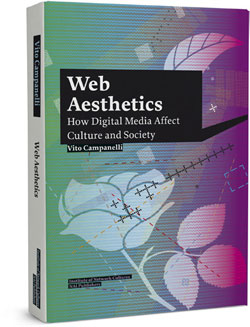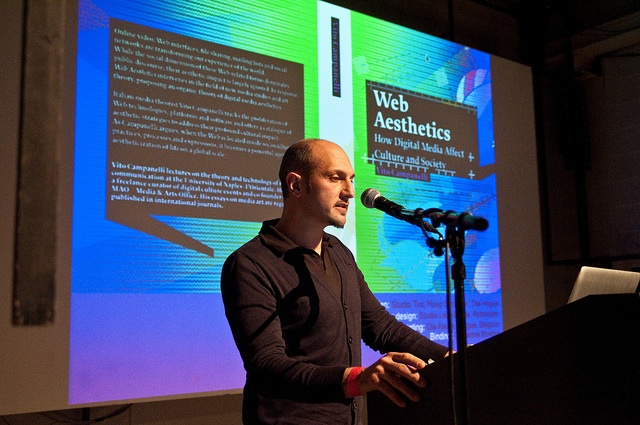By Nicola Bozzi
Vito Campanelli’s presentation of his own Web Aesthetics. How Digital Media
Affect Culture and Society (published by NAi) was one of the few theoretical ones in a very visual and demo-ridden Video Vortex edition.
In his work, the Italian scholar reduces important phenomena like social and peer-to-peer networks to their historical premises, laying the foundations for an organic aesthetic theory of digital media. His intervention outlined his conceptual framework, providing the common denominator to the examples analyzed in the book.

Taking the very cover of the volume as an example of how this world is dominated by surfaces, Campanelli proceeded to describe the progressive aestheticization of reality. He quoted well-known theorists of the simulacrum and the postmodern, like Jean Baudrillard and Fredric Jameson, but also Italian Ernesto Francalanci and his book Estetica degli oggetti (“Aesthetics of Objects”). It is through objects, or rather through their metamorphization from products to pieces of art, that Campanelli explores the diffused aesthetical dimension of our contemporary reality. When domestic objects no longer belong to the internal sphere, the home becomes the place where subjects feed the illusion shaping a virtualized and spectacularized reality. But if our possessions have become simulated fetishes, what have we become? Like several other speakers at the conference, Campanelli mentioned the amateur. We are all potential media amateurs, fascinated by a vertigo induced by world-making. As Baudrillard put it, “the object seduces us by giving us an illusion of power over it”.
Web Aesthetics are the distributed aesthetics of digital networks – which, according to Geert Lovink and Ned Rossiter, do not just reside on those networks, but are made by them. For this reason, like Aby Warburg‘s iconology, the Web retains the cultural memory of the Western world, as it sediments through the centuries.
The memes depicted in YouTube videos or animated GIFs (which we have heard so much about in Video Vortex) are highly expressive images that populate the tabula rasa of memory, spreading and surviving by memetic contagion. This last term suggests a viral component in the reproduction of images, intrinsically driven both to movement and preservation, that goes beyond the boundaries of the Web.



